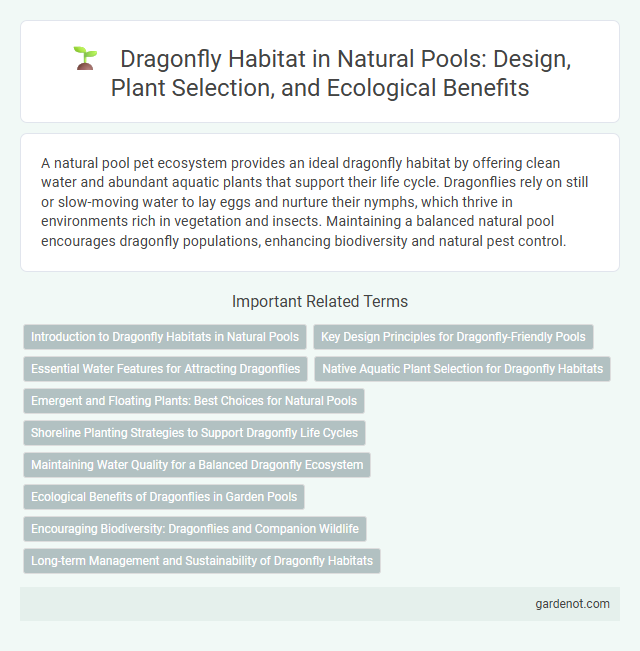A natural pool pet ecosystem provides an ideal dragonfly habitat by offering clean water and abundant aquatic plants that support their life cycle. Dragonflies rely on still or slow-moving water to lay eggs and nurture their nymphs, which thrive in environments rich in vegetation and insects. Maintaining a balanced natural pool encourages dragonfly populations, enhancing biodiversity and natural pest control.
Introduction to Dragonfly Habitats in Natural Pools
Dragonflies thrive in natural pool habitats where clean, still water supports aquatic plants and abundant insect life essential for their lifecycle. These environments provide ideal breeding grounds with submerged vegetation for egg-laying and larvae development. Preserving water quality and minimizing disturbances are crucial for maintaining healthy dragonfly populations in such ecosystems.
Key Design Principles for Dragonfly-Friendly Pools
Incorporate native aquatic plants such as water lilies and rushes to provide dragonfly nymphs with shelter and hunting grounds. Ensure gradual pool edges with shallow zones to facilitate dragonfly emerging while minimizing predators. Maintain chemical-free, clean water to support the entire dragonfly lifecycle and biodiversity in the natural pool ecosystem.
Essential Water Features for Attracting Dragonflies
Essential water features for attracting dragonflies in a natural pool include shallow, still water areas with abundant aquatic vegetation such as water lilies and reeds, which provide perching and breeding sites. Clear water with minimal pollutants supports the larval stage, while varied depths encourage diverse microhabitats essential for dragonfly nymph development. Incorporating sun-exposed edges and gentle slopes enhances habitat suitability, facilitating thermoregulation and hunting opportunities for adult dragonflies.
Native Aquatic Plant Selection for Dragonfly Habitats
Native aquatic plants such as water lilies, pickerelweed, and arrowhead provide essential habitat structures for dragonfly nymphs, offering shelter and hunting grounds in natural pools. Selecting native species ensures optimal water quality and supports the dragonflies' life cycle by providing breeding sites and perching spots for adults. Incorporating diverse native vegetation promotes a balanced ecosystem, enhancing biodiversity and the survival rate of dragonfly populations.
Emergent and Floating Plants: Best Choices for Natural Pools
Emergent and floating plants create ideal habitats for dragonflies in natural pools by providing essential perching sites and hunting grounds. Species such as cattails, water lilies, and hornwort support dragonfly nymphs by offering shelter and oxygenation within the water. These plants contribute to biodiversity, enhancing the natural ecosystem and promoting dragonfly population growth.
Shoreline Planting Strategies to Support Dragonfly Life Cycles
Shoreline planting strategies for natural pools enhance dragonfly habitats by incorporating native aquatic and emergent plants such as cattails, rushes, and sedges, which provide critical oviposition sites and shelter for larvae. Dense vegetation along the water's edge promotes water quality and temperature regulation, essential for the development of dragonfly nymphs through their aquatic life stage. Maintaining a diverse plant buffer zone reduces erosion and supports insect prey populations, sustaining the full lifecycle of dragonflies from egg to adult.
Maintaining Water Quality for a Balanced Dragonfly Ecosystem
Maintaining water quality in natural pools is crucial for supporting a balanced dragonfly habitat, as these insects rely on clean, oxygen-rich water for their nymph stage development. Monitoring parameters such as pH, temperature, and nutrient levels helps prevent algae overgrowth and ensures a healthy environment for both predator and prey species within the ecosystem. Regularly removing debris and avoiding chemical pollutants further sustains optimal conditions for dragonfly populations to thrive and reproduce effectively.
Ecological Benefits of Dragonflies in Garden Pools
Dragonflies contribute significantly to the ecological balance of natural garden pools by controlling mosquito populations, reducing the need for chemical pesticides. Their presence indicates good water quality, as dragonflies thrive in clean, pollutant-free environments. Moreover, dragonflies support biodiversity by serving as both predators and prey, enhancing the overall health of the aquatic ecosystem.
Encouraging Biodiversity: Dragonflies and Companion Wildlife
Dragonflies serve as key indicators of a healthy natural pool ecosystem, thriving in clean, well-oxygenated water with abundant aquatic plants. Their presence encourages biodiversity by supporting companion wildlife such as frogs, damselflies, and water beetles, which contribute to a balanced food web. Creating habitats with diverse vegetation and shallow water zones enhances breeding grounds for dragonflies, promoting ecological stability and natural pest control in the pool environment.
Long-term Management and Sustainability of Dragonfly Habitats
Sustaining dragonfly habitats in natural pools requires maintaining clean water quality, diverse aquatic vegetation, and stable wetland conditions to support their life cycle. Implementing buffer zones to reduce pollution and monitoring water levels help preserve breeding and feeding grounds essential for long-term population health. Adaptive management strategies that respond to environmental changes ensure the resilience and sustainability of dragonfly ecosystems over time.
Dragonfly habitat Infographic

 gardenot.com
gardenot.com